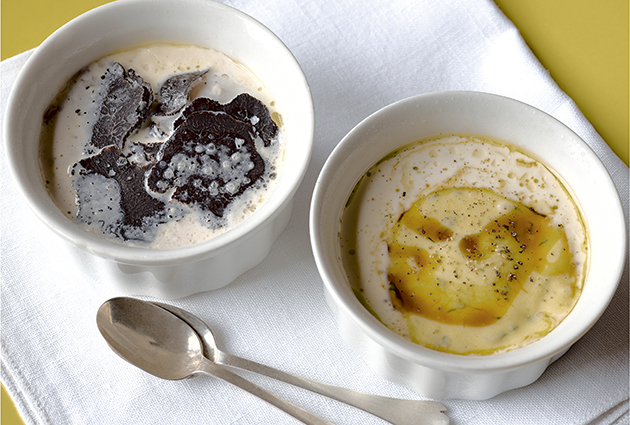Egg-ceptional baked eggs
Simon Hopkinson explains how to make the perfect baked egg, and suggests some toppings, from black truffles to béarnaise sauce


Sad as it is to say, I need to address a long-held concern to begin the New Year. However, do have a very happy 2016 nonetheless! Is it just me, or are many of the eggs that I find at farmer’s markets erratic, in both age and quality?
As a very sad recent example, the Sunday evening following a purchase of Saturday eggs, a favourite supper was to be some left-over cooked potatoes, fried until crisp in a capacious frying pan. Once they were at optimum crunch, I pushed them to the very edges of the pan and cracked two ‘farm’ eggs into the centre.
Well, would you believe, the whites were so old and watery, they managed to infiltrate the potatoes to the very edge of the pan. Even the yolks were as flat as pancakes and sagging in the middle, so weary were they with age. Just what is going on, here: poor rotation, over-production or badly supervised collection?
Furthermore, I don’t really mind a few smears (although I sometimes think, wearily, that this is simply to show off their ‘farm’ origins), but some can be so filthy that it’s simply off-putting and, knowing that an eggshell is porous, could a touch of taint have penetrated inside? I may be mistaken, here, but I’d simply rather not take home eggs that need the green-scourer treatment before cooking them.
And, with reference to my previous question as to age, quite how long have they been stored in this state?
All that might sound a little depressing and an unnecessarily brutal crushing of enterprising, small egg producers. However, I do sincerely ask that, when dis-playing great baskets, bowls and so many-layered cardboard trays of ‘farm eggs’, these estimable purveyors should at least guarantee freshness, however ‘freshly’ filthy they may look.
One only has to marvel at the chickens so carefully looked after by Clarence Court farm (www.clarencecourt.co.uk), to know who produces the freshest of eggs.
Exquisite houses, the beauty of Nature, and how to get the most from your life, straight to your inbox.
One of the simplest fresh egg dishes is a baked egg or egg en cocotte. All that’s necessary is to break an egg into a well-buttered ramekin, season and spoon a couple of tablespoons of cream over it. Place into a deep baking tin, pour hot (not boiling) water around the dish/dishes and bake for 7–10 minutes in the oven at 180˚C/gas mark 4.
After about five minutes, poke each one with a tentative finger just to be sure that the white has set sufficiently beneath. You should be able to detect when the yolk is perfect, sporting its strangely lilac-blue, opaque skin an immediate indication to those of you who are familiar with the frying and basting of a very fresh, blushingly golden egg yolk. That’s the elementary baked egg, but here are two further embellishments.
Baked egg with black truffles
As this is prime time of year for the purchase of a fresh black truffle or two, I cannot think of a more perfect way in which to enjoy these rare and wonderful, extravagant treats.
Method
Perfume some eggs with a fresh black truffle, in a sealed container and keep in the fridge for a minimum of two days. Rub the dish with a cut clove of garlic and smear with butter. Break an egg into the ramekin and season, then spoon one tablespoon of cream over it. Slip three or four slices of truffle into the cream and set a sliver of butter on the surface of the egg. Bake for 7–10 minutes, or until cooked to perfection.
Baked egg with béarnaise sauce and meat glaze
I first ate this delectable little egg dish in Lacy’s restaurant, in London, in the mid 1970s. Although it may sound a touch dated, believe me, it’s one of the very nicest Sunday-supper egg dishes I know.
Method
You will need to have a small bowl of béarnaise sauce to hand, together with some fine beef stock (or rich and tasty beef juices/thin gravy left over from Sunday roast beef) reduced until syrupy. Butter a ramekin dish, add no more than a trickle of cream and break in an egg.
Bake as for the truffled eggs above, then spoon half a tablespoon of béarnaise sauce over each and trickle with a couple of teaspoons of the meat glaze. Bliss!
Eggs Florentine
Serves 4
Ingredients
50g butter 500g fresh spinach, picked over, thoroughly washed and dried Salt, pepper and freshly grated nutmeg 4 eggs Vinegar 50g Parmesan, freshly grated
For the béchamel sauce
200ml milk 2 cloves 1 small onion, peeled and finely chopped 1 bay leaf Salt and pepper 40g butter 25g plain flour 75ml double cream
Method
Pre-heat the oven to 200˚C/gas mark 6. To make the sauce, heat together the milk, cloves, onion, bay leaf and seasoning. Remove from the heat, cover and leave to infuse for 30 minutes or longer. Now, melt the 40g butter in a heavy-based saucepan and stir in the flour to make a roux.
Strain the milk into the roux and whisk thoroughly. Bring to a simmer, gently, over a low heat for several minutes. Strain again and adjust the seasoning, then stir in the cream and keep warm.
Melt the 50g butter in a large shallow pan until just turning nut-brown. Put in the spinach, season with salt, pepper and nutmeg and stir-fry until limp and just cooked. Drain in a colander, pressing gently to extract excess moisture. Keep warm.
Poach the eggs in water, with a little vinegar added. Leave them a little undercooked. Meanwhile, divide the spinach between four shallow, individual dishes (the ones with ‘ears’ are perfect), leaving a hollow in the middle for the eggs.
Put an egg in each dish, pour some of the sauce over each, sprinkle with Parme-san and bake in the oven for 4–5 minutes. Finish off under a hot grill so that the sauce blisters somewhat and then sprinkle each serving with a little extra Parmesan. Serve forthwith.
